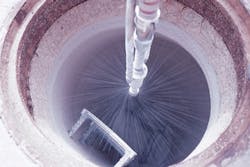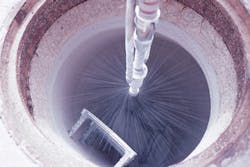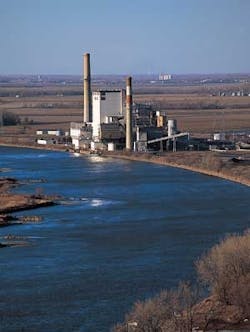Stepping up sludge-less, sludge processing systems
Reducing the amount of sludge from wastewater treatment processes has been a key target for utilities and other wastewater producers. Indeed, some systems claim almost-complete sludge obliteration. With new advances in transportable systems, is the rise and of sludgeless systems unstoppable? Lis Steadman reports.
With the estimated cost of sludge treatment and disposal going beyond €500 per dry tonne, sludge reduction is a desirable target. But there is a balance between energy and materials recovery and sludge reduction that is increasingly seen as key.
There are also two separate aspects: permanent treatment systems and temporary ones, for which sludge reduction is often a critical issue.
For the latter, US-based Global Water has recently delivered transportable wastewater recycling systems to the US Air Force that are said to generate virtually no sludge. Company founder Alan Weiss says the systems can be adapted to any purpose — "military, city, towns, both for water purification and wastewater recycling.
"The wastewater recycling system is a combination of technologies created 35 years ago for the oil and gas industry". He notes that conventional land-based wastewater systems were essentially developed a century ago "designed by civil engineers, who keep designing the same archaic systems". He adds: "They are major polluters. Newer plants add systems such as membranes and sequencing batch reactors (SBRs), but the bottom line is that you end up with sludge, and water soaked with chlorine that has to be dumped somewhere."
In the oil and gas industry, without the extensive areas required to dispose of sludges, biologists developed aerobic, enzyme-utilising processes that were able to eliminate sludge, he explains.
"Land-based processes use anaerobic processes that create more sludge which they try to eliminate later and can't do," Weiss notes.
Global Water has worked with the military for the last 20 years, he adds, who were keen to have sludge-eliminating wastewater treatment systems that could be used on bases with no negative environmental impact, thus avoiding any penalties that might be imposed by their host countries. Oil and gas companies have also approached the company for help in resolving their problems with drilling sludges, and the company has created a system in response that reduced the processing time by half.
"Instead of holding in the aerobic system for 24 hours, the time is cut to 12 hours. This means we are able to reduce the size of the steel containers and reduce the cost of the recycling and purification processes. The effluent coming out of the digester has a little more suspended solids but this is captured and put back into the digester."
The modular system uses three processes — a one micron strainer to remove parasites, a proprietary multi-media system (which is likened by Weiss to the ultra-secret Coca-Cola formula) and UV, to kill bacteria and viruses. "You end up with no sludge in the container and an effluent better than any water you can buy in the supermarket," he says.
Although the system is eminently transportable, he adds that it could be used to treat wastewaters from "any city in the world. Everything we do in wastewater is built to a modular format that provides the maximum efficiency in size.
"You just network the modules together — it is the PC of the water business, just as people found that networking PCs together made them more powerful. We make modules, and no matter what size the system footprint it is never larger than the equivalent footprint of an old conventional system. It's like cookie cutters — the parts are off the shelf, and it is easier to maintain."
Indeed, the company is working with a town in the state of Constanza, Romania, that has expressed interest in the system. "They want us to build one so they can see it," Weiss says.
The five systems for the US air bases are also currently being shipped and installed, and last year a small unit was shipped to Singapore, home of the most advanced wastewater treatment in the world.
Weiss points out that the system the national water agency PUB is using still creates sludge, and that the Global Water system could provide a "far superior" quality of wastewater. "PUB has now approved the Global Water system as the only approved alternative to its existing one," Weiss adds. The first system was delivered in 1999 to an oil rig in the Caspian Sea, he recalls, for an Exxon Mobil consortium. Here, the driver was a requirement not to pollute the delicate sturgeon grounds.
These modular systems could also potentially be extremely useful in disaster relief situations. "When you build temporary housing you can't break it because you have already created an environmental hazard and don't know what to do with the waste."
The main issue, as the company found in the wake of Hurricane Katrina and the earthquake in Haiti, is the reluctance of authorities to purchase wastewater treatment and the timescale. "I say get one for next year when you have the next hurricane, but they don't do it," Weiss notes.
He also argues that the system could be used in areas of very low rainfall for recycling back into reservoirs. "You need never suffer from drought," he explains.
"Our water quality output will exceed the NSF standard for potable water in the US, and the WHO standard." Although the initial cost of the equipment is "probably higher" than that of traditional systems, Weiss argues that this is compensated for by the fact that there is no need to handle or treat sludge.
Looking at more permanent treatment works solutions, research since the 1990s on alternative technologies to reduce on-site production of sludge has identified various ways to reduce the amount of sludge generated — for instance, ozonation, treatment with ultrasound, electrical treatment, thermal treatment, chemical and thermo-chemical hydrolysis and various combinations of these and other techniques.
Although sludgeless or sludge-reducing systems are clearly of considerable interest in relief situations, Veolia Water Solutions & Technologies' sludge and energy expert for the municipal market, Michel Coeytaux, explains that the municipal mindset has changed radically over the past three years.
"Our philosophy is to try to reduce the quantity of sludge after treatment, but first of all to gain the benefits of reducing sludge and simultaneously to produce energy from the carbon content in the sludge to provide a double effect — the carbon is extracted and used in the digestion process," he says.
Veolia Water Solutions & Technologies (VWS) has among its array of solutions the Biothelys® thermal hydrolysis system, which reduces the amount of sludge produced by up to 80% compared to conventional methods.
Coeytaux explains that VWS has also recently developed Exelys™, a continuous thermal hydrolysis process that significantly reduces sludge quantities, as well as the energy bill. "The aim is to reduce the amount of energy needed by the process and reduce the size of the plant. We also try to digest the sludge as much as possible so we can expect a significant reduction in organic content."
Reducing the amount of sludge produced means there is less going on to the next stage, drying, so the size of the drying plant required is also reduced and therefore the amount of energy used. VWS municipal marketing corporate director Arnaud de La Tour du Pin notes: "For all municipalities it is an issue — they want to reduce the cost of sludge disposal."
This is driven by factors such as the increasing difficulty of spreading sludge to land. De La Tour du Pin explains: "In Switzerland, spreading is forbidden — they have to have specific technologies for sludge disposal.
"There are areas world-wide where sludge disposal is forbidden or where the requirements are very strict."
Thermo-hydrology provides a means of complying with such rules, Coeytaux adds. "We heat the sludge at 160 degrees for at least half an hour. It means the cells are destroyed, so the organic matter is more available to the following digestion process."
Digestion and thermo-hydrology working together are seen as an ideal solution.
Where the restrictions are not so onerous, De La Tour du Pin says that current thinking is that "in water treatment the idea is to produce the maximum amount of sludge, and in sludge treatment the idea is to create value with the sludge."
Producing biogas and energy requires sludge as an input so in fact maximising the amount of sludge has merits that are increasingly being recognised. "It was different in the past, the idea was to reduce production of sludge but now it is to produce a large quantity and then profit from it if possible."
This idea is proving attractive in northern and eastern European countries, he adds, and has mainly taken hold because of the oil crisis. In the UK, there is a government requirement to reduce the energy consumption of wastewater treatment plants to 20% below 1990 levels by 2010 and 60% by 2050, with "real progress" by 2020, and also a carbon reduction commitment that comes into force this year to reduce plants' carbon footprints. These aims mean leveraging the energy production possibilities inherent in sludge is an attractive solution.
Where needed there are technologies such as wet oxidation and incineration that drastically reduce the amount of sludge produced — with incineration basically only minerals remain.
Coeytaux adds: "Wet oxidation is combustion of the biomass in special conditions at a temperature of 250ºC under around 50 bar pressure. Oxygen is injected into the sludge and the carbon content is transformed into CO2 gas during the process. Plants using this process are being used in France and Italy. It is used particularly where it is impossible for the client or municipality to dispose of sludge, and incineration is impossible for social reasons and public acceptance."
The Dutch Foundation for Applied Water Research, Stowa, has produced a roadmap for the wastewater treatment plant of 2030 that envisages a twin process of reducing the volume of sludge created and using the remaining organic matter for energy recovery. This also lists various techniques to achieve sludge reduction including thermal hydrolysis and enzymatic hydrolysis, which reduce the sludge water content by breaking down a complex chemical structure of nanomolecules or the structure of the micro-organisms.
Disintegration (cavitation) is mentioned, but experience with this in The Netherlands is noted as being limited. Mesophilic digestion and thermophilic digestion can be used to reduce the organic matter in sludge, the report notes, and the energy produced is mostly used at treatment works though some plants do sell excess energy back to the national grid. The residue is rich in N and P and requires final treatment. Final stage technologies such as incineration and drying further reduce the ultimate amount of sludge.
Furthermore, VWS has a solution developed by colleagues in Denmark called Biocon® +ERS that dries sludge and utilises the biogas, with the key attraction being that the drying process does not require outside energy input.
So far, there is a plant in the US and one in Poland. So-called "sludge greenhouses" which use the power of the sun to dry sludge are also seen as a good way of reducing the amount of sludge produced by utilising one of the world's great free energy sources.
De La Tour du Pin says that VWS has also gone a stage further and has undertaken research to make a bioplastic out of sludge. "We've done it but now we have to industrialise the process," he notes.
Although this is still at the research and development stage, it raises the interesting possibility that one day sludge may be viewed not as an inconvenient waste or even an energy source but the essential ingredient in an interesting new product. That really would be an ideal disposal route.
More Water & WasteWater International Current Issue Articles
More Water & WasteWater International Archives Issue Articles



